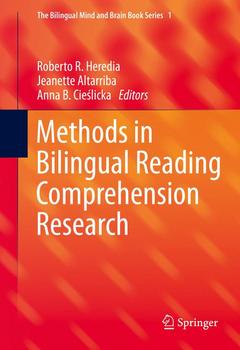Description
Methods in Bilingual Reading Comprehension Research, Softcover reprint of the original 1st ed. 2016
The Bilingual Mind and Brain Book Series, Vol. 1
Language: English
Subjects for Methods in Bilingual Reading Comprehension Research:
Keywords
Electrophysiology of the Bilingual Brain; On-line Multiple Language Activation; bilingual reading processing; bilingual sentence processing; cognition and bilingual reading; cognitive experiments in bilingualism; fMRI and language comprehension; psycholinguistic methodologies in bilingualism; psychology of bilingual reading; rapid serial visual presentation; reading integration in bilingual speaker
Publication date: 10-2015
Support: Print on demand
Publication date: 08-2016
Support: Print on demand
Description
/li>Contents
/li>Biography
/li>Comment
/li>
Roberto R. Heredia is a professor of psychology at Texas A&M International University (TAMIU); his research interests include Lexical access, bilingual lexical processes, lexical ambiguity, figurative language processes, sentence processing, second-language acquisition, word recognition, memory and information processing. He is a former Chair of the Behavioral Sciences department at TAMIU. He is a Series Coeditor for The Bilingual Mind and Brain Book Series, published by Springer.
Jeanette Altarriba is a professor of psychology at State University of New York, (SUNY) Albany as well as the Director of the Cognition and Language Laboratory at SUNY-Albany. Her research interests include psychology of language, psycholinguistics, second language acquisition, bilingualism, knowledge representation, eye movements and reading, concept and category formation and cognition and emotion.
Anna B. Cieślicka is an assistant professor of psychology at Texas A&M International University (TAMIU); her research focuses on the psycholinguistics of second language acquisition. She is a Series Coeditor for The Bilingual Mind and Brain Book Series, published by Springer.
Presents a comprehensive overview of the various psycholinguistic and neurophysiological tasks used to measure bilingual language processing
Combines major findings from classical behavioral cognitive methodologies and newly developing neuropsycholinguistics methodologies such as fMRI
Includes review questions and suggested student research projects at the conclusion of each chapter to enhance student comprehension
Includes supplementary material: sn.pub/extras




